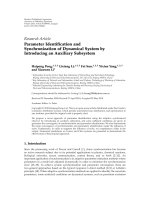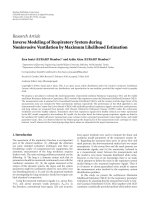01-Overview of PLC System Training PLC Allen Bradley
Bạn đang xem bản rút gọn của tài liệu. Xem và tải ngay bản đầy đủ của tài liệu tại đây (1.62 MB, 42 trang )
DAY 1
SESSION 1
1-1
OVERVIEW OF AB PLC’S SYSTEM
Overview of AB PLC’s System
6 – 10 December 2010
WHAT IS PLC?
• Programmable Logic Controller (PLC) or programmable
controller is a computer-based device that used to control
industrial equipment.
• Used to replace relay functions.
1-2
• PLC controlling an equipment based on input/output status of
the equipment and logical program.
Overview of AB PLC’s System
6 – 10 December 2010
RELAY
• Relay was used for control logic.
• Relay is a simple device that use magnetic field to control the
switch.
• Contact that will be closed when the coil energized is called
normally open.
• Contact that will be closed when the coil wasn’t energized is
called normally closed.
1-3
Coil
Arus Listrik
Overview of AB PLC’s System
6 – 10 December 2010
1-4
HOW DOES RELAY CONTROL?
Overview of AB PLC’s System
6 – 10 December 2010
1-5
EQUIVALENCY BETWEEN RELAY
AND PLC PROGRAM
Overview of AB PLC’s System
6 – 10 December 2010
1-6
PLC SYSTEM ARCHITECTURE
Overview of AB PLC’s System
6 – 10 December 2010
BASIC COMPONENTS OF PLC
• Processor
• Memory
outputs
inputs
• Power Supply
I/O System
Power Supply
• I/O Interface
• Programming Device & Languages
PROCESSOR
Memory
Unit
1-7
Programming
Device
Overview of AB PLC’s System
6 – 10 December 2010
HOW DOES A PLC WORK ?
• Examine the status of inputs and outputs
• Controls some process or machine through outputs using
some control logic
• This control logic is executed periodically by the processor in
a predetermined sequential order
1-8
• User can change the control logic using a programming
language and it is stored in the program memory
Overview of AB PLC’s System
6 – 10 December 2010
PLC WORK
POWER ON
Sanity Check
STOP
Indikator On
Yes
Error
No
Save to
Memori
Scanning
All Inputs
Ladder Logic Solved
Outputs Change
Overview of AB PLC’s System
6 – 10 December 2010
1-9
Scanning
All Outputs
PLC WORK (2)
Real Input
POWER ON
Scanning
Input
New
Output
Overview of AB PLC’s System
1-10
Scanning
Operation
Execution!
6 – 10 December 2010
PROCESS CONTROL USING PLC
1-11
Input
• Use input from the
sensor to make logical
decision, and;
• Update the output to
drive the actuator
Output
When a process being
controlled, PLC:
Overview of AB PLC’s System
6 – 10 December 2010
TYPICAL CONFIGURATIONS FOR
PLC
Large
• Small Size:
Medium
• Up to 128 I/O
• Memory up to 2 KB
• Medium Size:
• Up to 2048 I/O
• Memory up to 32 KB
• Up to 16000 I/O
• Memory up to 2 MB
Small
Overview of AB PLC’s System
Micro
6 – 10 December 2010
1-12
• Large Size:
PROCESSOR & MEMORY
input bus
System
Clock
I/O
Port
•
80386/80486 microprocessor
based
•
Random Access Memory (RAM)
•
Electrically Erasable Programmer
Read Only Memory (EEPROM)
Overview of AB PLC’s System
Data
Memory
Program
Memory
address bus
Instruction Cycle :
• Fetch the next instruction from
program memory
• Place it in the instruction register in
the CPU
• Increment the program counter by
one
• Execute the instruction
6 – 10 December 2010
1-13
CPU
output
bus
ALLEN-BRADLEY PLC
PROCESSORS
SLC 5/03
• 1747-L53x
SLC 5/04
• 1747-L54x
• RS-232
• 1 DH-485 (1747-L53x)
• 1 DH+ (1747-L54x)
• 1 EtherNet/IP (1747L55x)
Networks Through
Additional Modules
• DeviceNet
• EtherNet/IP
Each interface uses an
RS-232 port.
SLC 5/03
• 1747-L55x
EtherNet/IP PLC-5
• 1785-LxxE
• RS-232
• 1 EtherNet/IP
• up to 2 DH+/Universal
Remote I/O
ControlNet PLC-5
• 1785-LxxC15
• RS-232
• 1 ControlNet
• up to 2 DH+/Universal
Remote I/O
DH+ PLC-5
• 1785-LxxB
• RS-232
• up to 4 DH+/Universal
Remote I/O
Overview of AB PLC’s System
• DeviceNet
• EtherNet/IP
Local
I/O
Total I/O
(Local and
Distributed)
32
local only
136
local only
540
additional I/O capacity
with DeviceNet I/O
512
3,072 additional I/O
capacity with
DeviceNet, ControlNet
and Universal Remote
I/O
1-14
Controller
Built-in
Communication
Ports
6 – 10 December 2010
ALLEN-BRADLEY PLC
PROCESSORS (2)
Controller
RS-232
1 EtherNet/IP
1 ControlNet
DH-485 (via RS-232)
Modbus via ladder
routine (via RS-232)
Local
I/O
• DeviceNet
960
digital
9000 digital
or
256 analog
additional I/O capacity
with DeviceNet I/O
512
128,000 digital
or
4,000 analog
additional I/O capacity
with DeviceNet I/O
512
digital
distributed I/O via
DeviceNet, ControlNet,
and EtherNet/IP
CompactLogix:
• 1769-L31
• 1769-L32C, 1769L32E
• 1769-L35CR, 1769L35E
•
•
•
•
•
ControlLogix:
• 1756-L55
• 1756-L61, 1756-L62,
1756-L63
• 1756-L60M03SE
• RS-232
• DH-485 (via RS-232)
• Modbus via ladder
routine (via RS-232)
•
•
•
•
•
FlexLogix:
• 1794-L34
• RS-232
• DH-485 (via RS-232)
• Modbus via ladder
routine (via RS-232)
• DeviceNet
• ControlNet
• EtherNet/IP
Overview of AB PLC’s System
Total I/O
(local and
distributed)
Networks through
additional modules
DeviceNet
ControlNet
EtherNet/IP
DH+
Universal Remote I/O
128
analog
1-15
Built-in
communication
ports
6 – 10 December 2010
1-16
ALLEN-BRADLEY PLC
PROCESSORS (3)
Overview of AB PLC’s System
6 – 10 December 2010
INPUT/OUTPUT SYSTEMS
• Discrete Inputs/Outputs
• Analog Inputs/Outputs
• Special Purpose Modules
• Intelligent Modules
1-17
• Communication Modules
Overview of AB PLC’s System
6 – 10 December 2010
DESIGNING I/O SYSTEMS :
ELECTRICAL
Input voltage rating
• Lists the magnitude and type of
signal the module will accept
Input current rating
• The minimum input current required
at the module’s rated voltage that
the field device must be capable of
supplying to operate the input
module circuit
Input threshold voltage
• The voltage at which the input signal
is recognized as being ON/true
Output voltage rating
Output current rating
• The maximum current that a single
output circuit in a module can safely
carry under load
Output power rating
• The maximum total power that an
output module can dissipate with all
output energized
Backplane current requirements
• Lists the current demand that a
particular I/O module internal
circuitry places on the rack power
supply
1-18
• The magnitude and type of voltage
that can be controlled within a stated
tolerance
Overview of AB PLC’s System
6 – 10 December 2010
DESIGNING I/O SYSTEMS :
MECHANICAL
Number of I/O points per module
Number of wires
Wire size specification
• Number of conductors
• Largest wire gage that the I/O terminal points will accept
Ambient temperature rating
• Based on the heat dissipation characteristics of the circuit
components inside the I/O module
• 0 - 60 C typical
Humidity rating
Overview of AB PLC’s System
1-19
• 5 - 95 % typical relative humidity
6 – 10 December 2010
PROGRAMMING DEVICES
Used to enter, store, and monitor the PLC software
PC-based system
Connected to the PLC only during :
• programming & testing
• startup
• troubleshooting
communication
cable
Overview of AB PLC’s System
6 – 10 December 2010
1-20
I/O Modules
TC
TC
TC
TC
AO
AO
AI
AI
AI
DO
DO
DO
DI
DI
PLC
DI
POWER
SUPPLY
DI
PLC
Communication
Card
Personal Computer
AB PLC PROGRAMMING SOFTWARE CONFIGURATION
RSLogix
Programming
Software
Driver :
- RS232
- RS 485
- ENET
- DH+
1-21
RSLinx
Communication
Software
Programming
& Communication
Software
Driver :
- RS232
- RS 485
- ENET
- Modbus
Overview of AB PLC’s System
6 – 10 December 2010
IEC1131-3 STANDARD LANGUAGES
Ladder Diagram (LD)
• Uses a standardized set of ladder logic symbols
Sequential Function Charts (SFC)
• Blocks connected together like a circuit diagram
Functional Block Diagram (FBD)
• A graphical language used to describe sequential operations
Instruction List (IL)
• Low level language
Structured Text (ST)
1-22
• High level structured language designed for automation processes
Overview of AB PLC’s System
6 – 10 December 2010
LADDER DIAGRAM (LD)
Representations of relay ladder diagrams
The most widely used
Composed of six categories of instructions
1-23
• Relay type
• Timer/counter
• Data manipulation
• Arithmetic
• Data transfer
• Program control
Overview of AB PLC’s System
6 – 10 December 2010
SEQUENTIAL FUNCTION CHARTS
(SFC)
• Represented as a set of well-defined steps, linked by
transitions
1-24
• Actions within the steps are detailed by using the Structured
Text language (ST)
Overview of AB PLC’s System
6 – 10 December 2010
FUNCTIONAL BLOCK DIAGRAM
(FBD)
• Describes a relationship or function between input and output
variables
• Well suited for many applications involving the flow of
information or data between control components
• Allows the programmer to build complex control procedures
• Extensive function blocks library is provided
ALM_01
ALM
0
...
Alarm
LV001
0
In
HHAlarm
90
0
90
HHLimit
HAlarm
HLimit
LAlarm
LLimit
LLAlarm
70
70
0
0
0
LLLimit
ROCPosAlarm
Deadband
ROCNegAlarm
10
10
Overview of AB PLC’s System
0
6 – 10 December 2010
1-25
30
30









